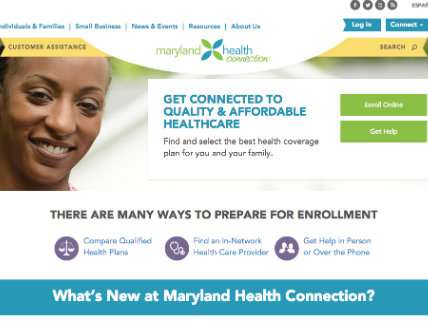Maryland's Obamacare Exchange Launch Was Also a Disaster

The botched launch of Obamacare's federal exchange system was front and center in the news for the last three months of 2013. All the attention paid to the federal system, which covered 36 states, distracted somewhat from the fact that several of the state-run exchanges were arguably even worse off.
One of those states was Maryland—which, funny enough, was repeatedly touted as an example of how Obamacare's exchanges could work if state officials wanted them to work and were proactive about implementation. President Obama went to Maryland to deliver a big health care speech a few days before the October launch of the exchanges, praising Maryland's elected officials for their efforts. The state was even given a $6.7 million "early innovator" grant by the federal government, which hoped that the Maryland exchange could serve as a model for other states.
But state and federal officials working on the exchanges had known for months that Maryland's exchange build out had huge problems, according to a big Washington Post feature from this weekend on the state's disastrous exchange development process.
According to the Post's report, an outside audit from the consulting firm BerryDunn warned state officials in a late 2012 presentation that they were underprepared, and that there were big risks to the project. For example, the report says, "no one could produce for BerryDunn standard project plans showing a timeline and checklist for how the main IT contractor…would get the job done." Nor was there anyone in charge. Even after the state finally hired an exchange director to manage the project, BerryDunn continued to warn that the project lacked a clear plan and timeline for completion.
In June of 2013, the project team managed to cobble a basic system together in order to pass a basic test proving that their system could talk to the federal data hub. But two months later, when it came time to show the system could do more than that, the exchange crashed and burned, reports the Post:
On Aug. 26, five weeks before the launch date, Maryland faced its final major test with federal overseers, a more thorough demonstration of how each part of its system would work. This one did not go as well. When the test got to the part of having a fictitious person choose a health plan, the Web site crashed. It also could not fully send enrollment data to insurers or e-mail Marylanders when they successfully selected a plan — something it still cannot do.
A final prelaunch test the next month wasn't much better:
… Testers filed their final report on Sept. 13, calling the last version of the software they could review "extremely unstable." Internal testing of one aspect of the site found 449 defects, almost half of which would probably trouble the final release.
Not surprisingly, launch day was a mess:
More than 24 hours after the launch, there were just four people who had selected plans and eight more who appeared to have logged on.
An IT contractor wrote to state officials on Oct. 2 wondering if the four were "legitimate," since contractors could not even access the site. She questioned if they might be fictitious accounts from prior phases of testing.
Maryland's troubled experience trying to build its own exchange isn't unique. Oregon, Minnesota, Vermont, Massachusetts, and Hawaii have all had (and in some cases still have) serious glitches with their exchanges, despite hundreds of millions in federal grants doled out to states building those systems. (Maryland alone got a total of $171 million from the federal government.) The widespread launch failures of so many exchanges, at both the federal and state levels, suggests that many of the problems were inherent in the basic conception of the exchanges, and that even if there had been near universal political support for implementation, failure was at least as likely as success.


Show Comments (33)